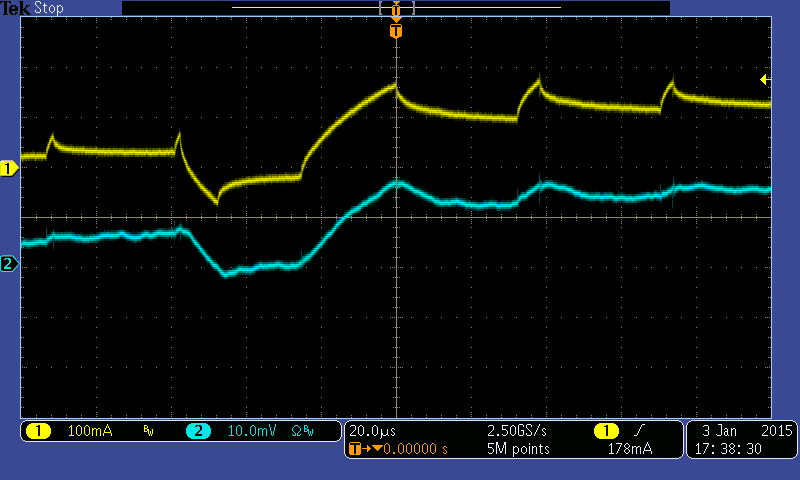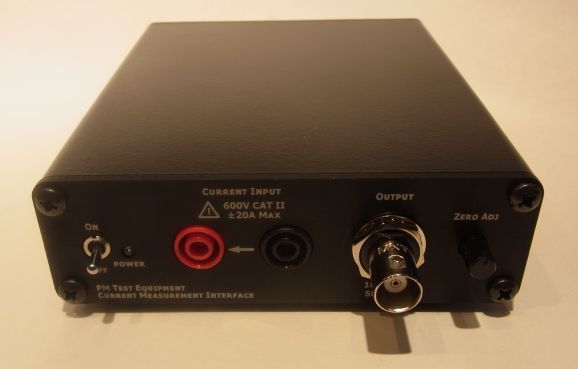
Current Measurement Interface
The PM-TE Current Measurement Interface is a device designed to allow you to accurately measure AC and DC currents with an oscilloscope. If is functionally similar to an oscilloscope current probe, but it is MUCH less expensive.
It uses an isolated Hall effect transducer to generate a voltage that's proportional to the current (AC, DC, or a combination) that is passed through the device. That voltage is amplified and centered at 0 volts to drive a 50Ω load (normally the input of an oscilloscope).
Isolated measurement of AC and DC current is crucial in the design and development of power supplies and motor driver electronics. The usual instrument that is used is an oscilloscope current probe. Unfortunately, current probes are very expensive - for example, the list price of the Tektronix® TCP0020 (one of the least expensive probes) is over $2500! This price not only puts it out of reach for hobbyists and casual users, but even makes it difficult for engineers at large companies to get approval for their purchase.
Current probes like the TCP0020 are fine pieces of equipment, and we highly recommend them if the application needs their bandwidth or precision. But for most power supply and motor control development work, they have more capability than what is needed. So we developed a less expensive alternative.
While it does not match the capabilities of more expensive probes, and it requires you to break the circuit instead of clamping over a wire, it is priced almost 90% lower!
The following table compares some key features of the PM-TE interface with the Tektronix® TCP0020:
| PM-TE Current Measurement Interface | Tektronix® TCP0020 | |
| Price | $290 | $2,590 |
| Bandwidth | 400 kHz | 50 MHz |
| Max. Current | 20 A | 20 A |
| Accuracy | ±2% | ±1% typical, ±3% max |
| Linearity | ±2% of full scale | not specified |
| Maximum voltage | 600V CAT III | 150V CAT II (bare wire) |
| Rise time | 1µS | 7nS |
| Output Noise | < 2mV RMS | not specified |
| Scaling | 100mV/A | not applicable |
| Connection | banana jacks | clamp over wire |
What's included:
Current measurement interface
DC wall adapter
1M BNC-BNC cable
Instruction sheet
Download Instruction Sheet (PDF file)
Here are some waveforms comparing a TCP0020 with the PM-TE interface. In all cases, the scales are the same. The yellow trace is the TCP0020; the blue is the PM-TE interface. Both have been set to 20MHz bandwidth to eliminate out-of-band noise.
The first and second waveform show a 1A, 60Hz sine wave, with the traces moved apart, then on top of one another:


This shows a triangle wave at 100Hz, around 6A peak-to-peak. You can see that the PM-TE interface is not quite as linear crossing zero (the yellow line is slightly curved). This is because the transducer core has a small amount of magnetic hysteresis. This error is less than 2% of full-scale.

This waveform shows the current through a stepper motor winding at 1/16-step and 1A peak current. The traces are virtually indistinguishable at this level.
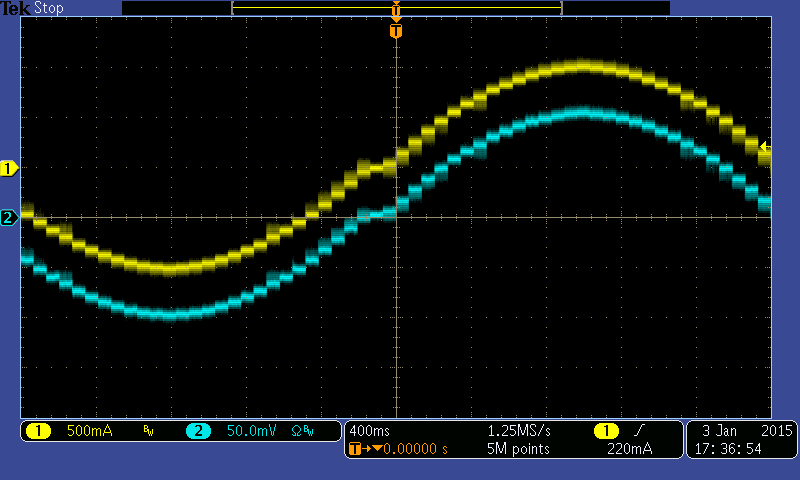
Another stepper motor, half stepping at changing speed.
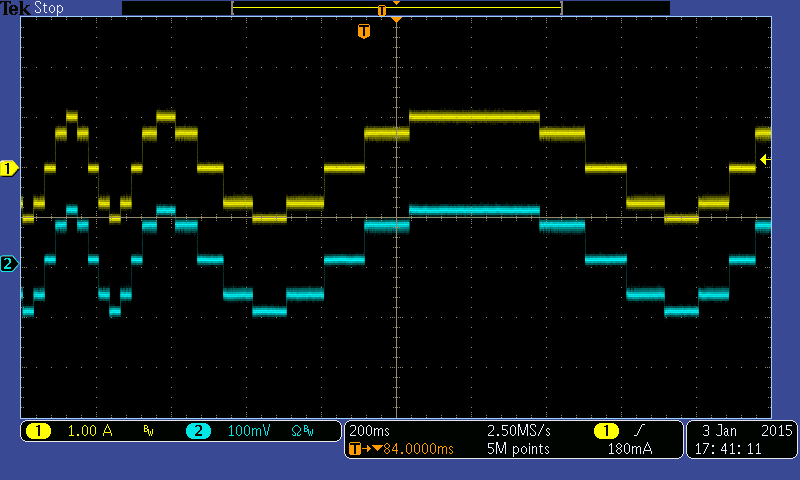
This shows the zero current transition for the stepper running at 1/16step.

This zoom shows the~ 27kHz PWM operation at the lowest current step past zero. Note the scale - the current measured is about 40mA. The PWM operation is clear, including the transition from fast decay to slow decay. (Also note that every 2nd or 3rd cycle is being skipped - this is a feature of this particular controller to regulate very low currents).
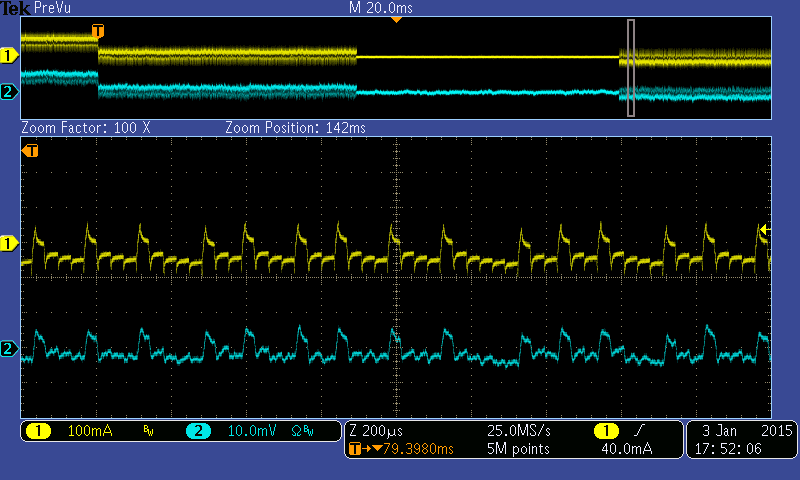
Another step transition showing the PWM and fast/slow decay transitions.
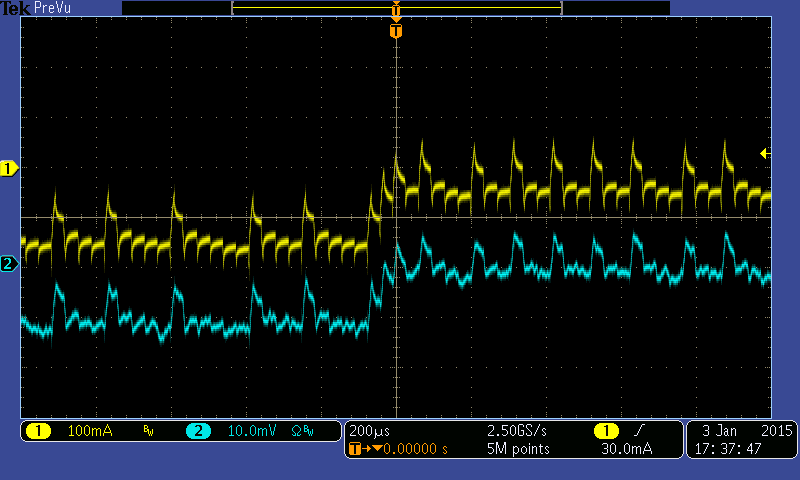
In this zoomed image, you can clearly see the limitations of the PM-TE interface bandwidth / slew rate and noise - the very sharp peaks that can be seen on the TCP0020 waveform are not visible on the PM-TE waveform, and some noise is visible. But the information is still more than adequate for debugging the PWM operation.
